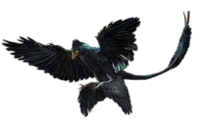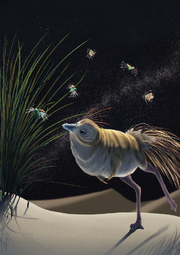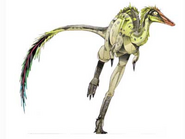
| Shuvuuia Temporal range: Late Cretaceous | |
|---|---|

| |
| Reconstruction of Shuvuuia deserti by
Gabriel N. U. | |
| Scientific classification | |
| Kingdom: | Animalia |
| Phylum: | Chordata |
| Class: | Sauropsida |
| clade: | Dinosauria |
| Suborder: | Theropoda |
| Family: | †Alvarezsauridae |
| Genus: | †Shuvuuia Chiappe, Norell, & Clark, 1998 |
| Species: | S. deserti |
| Binomial name | |
| Shuvuuia deserti Chiappe, Norell, & Clark, 1998 | |
Shuvuuia is a genus of Alvarezsaurid theropod dinosaur from the late Cretaceous period of Mongolia. Only one species, the type species Shuvuuia deserti (means "desert bird"), is currently known. The generic name Shuvuuia is derived from the Mongolian word shuvuu (шувуу) meaning "bird".
Description[]

The size of Shuvuuia (in blue) compared to a human and other Alvarezsaurids.
Shuvuuia was a small and lightly built animal. Only reaching lengths of around 60 cm (2 ft) in length, it is one of the smallest known dinosaurs. The skull is lightly built with long and slender jaws and minute teeth. Shuvuuia is unique among non-avian theropods in the skull's ability to perform prokinesis, that is, it could flex its upper jaw independently of its braincase.[1]

Skeletal reconstruction of Shuvuuia deseri
The hindlimbs of Shuvuuia were long, slender, and short-toed, which may indicate significant running capabilities. The forelimbs, however, were unusually short and powerfully constructed. Although originally Shuvuuia and other alvarezsaurids were thought to have only a single digit on the front limb, newer specimens show the presence of reduced second and third fingers in addition to the massively enlarged thumb known from previous specimens. Like other alverezsaurids, Shuvuuia may have used its forelimbs to open insect nests, and its slender, unusually mobile jaws to probe after such prey.
Fossils of Shuvuuia are currently known from two locations within the Djadochta Formation: Ukhaa Tolgod and Tögrögiin Shiree. These sites are thought to be about 75 million years old (late Campanian age). Contemporary genera included Velociraptor and Protoceratops.
Paleobiology[]

Illustration of a Nocturnal hunting Shuvuuia.
Nocturnal adaptations[]
A recent study in May 6, 2021, suggests that Shuvuuia might've been a primarily nocturnal hunter due to its incredibly sensitive hearing and enlarged eyes suggesting a very developed night vision. The study also included Haplocheirus, a similar coelurusaur.[2][3][4]
In popular culture[]
- Shuvuuia appeared on Dinosaur Planet.
Gallery[]
References[]
- ↑ https://scitechdaily.com/shuvuuia-extraordinary-dinosaurs-that-hunted-in-the-dark/
- ↑ https://www.usatoday.com/story/news/nation/2021/05/06/little-bird-like-dinosaur-hunted-night-study-suggests/4975565001/
- ↑ https://theconversation.com/nocturnal-dinosaurs-night-vision-and-superb-hearing-in-a-small-theropod-suggest-it-was-a-moonlight-predator-160152
- ↑ https://www.newscientist.com/article/2276926-owl-like-dinosaurs-had-remarkably-good-hearing-and-night-vision/







